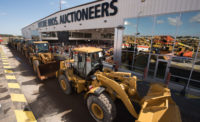
Hammer Time at Richie Bros. Auction
Nearly a third of the $176-million gross sales at last month's Ritchie Bros. Orlando auction went to internet bidders, setting a new company record. "Prices were strong for the smaller heavy construction items as well as one of the nicest selections of cranes that we've ever sold in our yard here in Orlando," says Steve Kriebel, regional sales manager for the Canada-based auctioneer.
Held on Feb. 18-23, the no-reserve annual auction saw 9,400 pieces of equipment cross the block, with roughly one third going to non-U.S. buyers. The sale generated approximately $18,700 per lot, an 8% drop since last year's event. Among the featured items were a 2012 Grove 90-ton rough-terrain crane that sold for $725,000 and 40 International trucks from Walmart's fleet.
Dodge Construction Starts Post Sharp Monthly Decline
The value of new construction starts dropped 12% in January to a seasonally adjusted annual rate of $469.1 billion, according to Dodge, a division of McGraw-Hill Construction. The decline followed a sharp 23% increase in December and brought the level of contracting back to the average pace that was reported during 2012.
"The pullback for construction starts in January was not surprising, given the up-and-down pattern that was present for much of 2012," says Robert Murray, chief economist for McGraw-Hill Construction. "The automatic spending cuts as part of the sequestration process [are] likely to restrain the fragile economic expansion," Murray adds. "The upward trend for housing is still expected to continue during 2013, along with modest improvement for commercial building, but this year's prospects for institutional building and public works remain in doubt."
Best-Practices Guide Coming For Building Information Modeling
The American Institute of Steel Construction is calling for proposals, by March 27, for the development of a best-practices guide on the use of building information modeling in structural steel construction. AISC is trying to standardize BIM use in a way that is cohesive and consistent with the checks and balances currently provided in its Code of Standard Practice for Steel Buildings and Bridges.
Few aspects of BIM have become standard, which has hampered the ability of AISC's code committee to incorporate provisions related to BIM into the code, says Charles J. Carter, an AISC vice president and its chief structural engineer. AISC's code committee is requesting assistance from BIM users, including engineers, fabricators, erectors, detailers, architects and contractors. Details, including the request-for-proposal form, are available at www.aisc.org. The group expects to publish the guide in fall 2014.
Midwest Utility AEP and EPA Reach Multi-Site Emissions Pact
Under an agreement reached on Feb. 25 with the U.S. Environmental Protection Agency, eight states and 13 environmental groups, American Electric Power (AEP), Columbus, Ohio, has agreed, by 2015, to stop burning coal at two powerplants in Indiana and Ohio and either retrofit, retire or refuel with natural gas another in Kentucky. AEP also committed to stronger sulfur-dioxide emissions limits at 16 of its coal-fired powerplants, the development of 50 MW of wind or solar power this year and payment of millions of dollars to states and citizens groups for pollution-mitigation efforts. In exchange, AEP will be allowed to install cheaper SO² control equipment at its Rockport, Ind., powerplant.
The agreement, which amends a 2007 settlement, still must be approved by the U.S. District Court in Cincinnati. AEP says it will save more than $1 billion from installing dry-sorbent injection technology on the Rockport plant, instead of the previously required flue-gas desulfurization. But the utility and its subsidiaries must reduce total SO² emissions at the other plants by 90% by 2029, a more aggressive pace than in the original pact.





Post a comment to this article
Report Abusive Comment